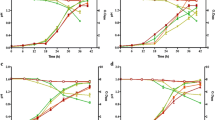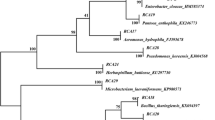Abstract
It has been reported that PGPB, containing ACC deaminase, can cleave the plant ethylene precursor ACC and thereby lower ethylene concentration in a developing or stressed plant, protecting it against the deleterious effects of stress ethylene and facilitating the formation of longer roots. In a previous work we have demonstrated expression of the ACC deaminase gene (acdS) from Enterobacter cloacae UW4 under the control of the lac promoter in Azospirillum brasilense Cd. With the inference that a construct including the ACC deaminase gene under the control of a constitutive promoter weaker than the lac promoter might impose less metabolic load on Azospirillum and improve its fitness, it was decided to clone acdS under the control of a tetracycline resistance gene promoter. The ACC deaminase structural gene was fused to the Tet r gene promoter by overlap extension using PCR, cloned in pRK415, and transferred into A. brasilense Cd. The resulting transformants showed lower ACC deaminase activity than those with the lac promoter controlled acdS gene. However, acdS under the control of the Tet r gene promoter imposed lesser metabolic load on Azospirillum brasilense Cd. The result was significantly increased IAA synthesis and greater bacterial growth rate, as well as increased ability to survive on the surface of tomato leaves and to promote the growth of tomato seedlings.









Similar content being viewed by others
References
Y Bashan (1993) ArticleTitlePotential use of Azospirillum as biofertilizer. Turrialba 43 286–291
Y Bashan (1999) ArticleTitleInteractions of Azospirillum spp. in soils: a review. Biol Fertil Soils 29 246–256 Occurrence Handle10.1007/s003740050549 Occurrence Handle1:CAS:528:DyaK1MXkt1OktLY%3D
Y Bashan G Holguin (1993) ArticleTitleAnchoring of Azospirillum brasilense to hydrophobic polystyrene and wheat roots. J Gen Microbiol 139 379–385 Occurrence Handle1:CAS:528:DyaK3sXkt1CmsLg%3D
Y Bashan H Levanony RE Whitmoyer (1991) ArticleTitleRoot surface colonization of non-cereal crop plants by pleomorphic Azospirillum brasilense Cd. J Gen Microbiol 137 187–196
Y Bashan M Singh H Levanony (1988) ArticleTitleContribution of Azospirillum brasilense Cd to growth of tomato seedlings is not through nitrogen fixation. Can J Bot 67 2429–2434
Y Bashan A Rojas ME Puente (1999) ArticleTitleImproved establishment and development of three cactus species inoculated with Azospirillum brasilense transplanted into disturbed urban desert soil. Can J Microbiol 45 441–451 Occurrence Handle1:CAS:528:DyaK1MXltVCjtLo%3D
GA Beattle SE Lindow (1999) ArticleTitleBacterial colonization of leaves: a spectrum of strategies. Phytopathology 89 353–359
F Bolivar RL Rodriguez PJ Greene MC Betlach HL Heyneker HW Boyer JH Crosa S Falkow (1977) ArticleTitleConstruction and characterization of new cloning vehicles. II A multipurpose cloning system. Gene 2 95–113 Occurrence Handle1:CAS:528:DyaE1cXhtFOls7g%3D
R Bordner J Winter (1978) ArticleTitleMicrobial Methods for Monitoring the Environment (Water and Wastes). EPA Occurrence Handle1:STN:280:CSeC2sbnsl0%3D Occurrence Handle148706
M Bradford (1976) ArticleTitleA rapid and sensitive method for the quantification of microgram quantities of protein utilizing the principle of protein-dye binding. Anal Biochem 72 248–254 Occurrence Handle10.1006/abio.1976.9999 Occurrence Handle1:CAS:528:DyaE28XksVehtrY%3D Occurrence Handle942051
MT Brandl SE Lindow (1998) ArticleTitleContribution of indole-3-acetic acid production to the epiphytic fitness of Erwinia herbicola. Appl Environ Microbiol 64 3256–3263 Occurrence Handle1:CAS:528:DyaK1cXmtVajsbs%3D Occurrence Handle9726868
GI Burd DG Dixon BR Glick (1998) ArticleTitleA plant growth-promoting bacterium that decreases nickel toxicity in seedlings. Appl Environ Microbiol 64 3663–3668 Occurrence Handle1:CAS:528:DyaK1cXms1entr4%3D Occurrence Handle9758782
S Burdman E Jurkevitch B Schwartsburd M Hampel Y Okon (1998) ArticleTitleAggregation in Azospirillum brasilense: effects of chemical and physical factors and involvement of extracellular components. Microbiology 144 1989–1999 Occurrence Handle1:CAS:528:DyaK1cXltVyhsb4%3D Occurrence Handle9695932
DH Figurski DR Helinski (1979) ArticleTitleReplication of an origin-containing derivative of plasmid RK2 dependent on a plasmid function provided in trans. Proc Natl Acad Sci USA 76 1648–1652 Occurrence Handle1:CAS:528:DyaE1MXitVSitr0%3D Occurrence Handle377280
BR Glick (1995a) ArticleTitleThe enhancement of plant growth by free-living bacteria. Can J Microbiol 41 109–117 Occurrence Handle1:CAS:528:DyaK2MXks1ygsrY%3D
BR Glick (1995b) ArticleTitleMetabolic load and heterologous gene expression. Biotechnol Adv 13 247–261 Occurrence Handle1:STN:280:DC%2BD3svnsVWmsw%3D%3D
BR Glick C Liu S Ghosh EB Dumbroff (1997) ArticleTitleEarly development of canola seedlings in the presence of the plant growth-promoting rhizobacterium Pseudomonas putida GR12-2. Soil Biol Biochem 29 1233–1239 Occurrence Handle1:CAS:528:DyaK2sXksFCnsrY%3D
BR Glick DM Penrose J Li (1998) ArticleTitleA model for the lowering of plant ethylene concentrations by plant growth-promoting bacteria. J Theor Biol 190 63–68 Occurrence Handle1:CAS:528:DyaK1cXhs1Oks7o%3D Occurrence Handle9473391
BR Glick CL Patten G Holguin DM Penrose (1999) Biochemical and Genetic Mechanisms Used by Plant Growth Promoting Bacteria. Imperial College Press London
SA Gordon RP Weber (1951) ArticleTitleColorimetric estimation of indoleacetic acid. Plant Physiol 26 192–195 Occurrence Handle1:CAS:528:DyaG3MXis1Glsw%3D%3D
B Grichko BR Glick (2000) ArticleTitleIdentification of DNA sequences that regulate the expression of the Enterobacter cloacae UW4 1-aminocyclopropane-1-carboxylic acid deaminase gene. Can J Microbiol 46 1159–1165 Occurrence Handle1:CAS:528:DC%2BD3MXpvFam Occurrence Handle11142408
JA Hall DC Peirson S Ghosh BR Glick (1996) ArticleTitleRoot elongation in various agronomic crops by the plant growth promoting rhizobacterium Pseudomonas putida GR12-2. Isr J Plant Sci 44 37–42
D Hanahan (1983) ArticleTitleStudies on transformation of Escherichia coli with plasmids. J Mol Biol 166 557–580 Occurrence Handle1:CAS:528:DyaL3sXkvVCqtL4%3D Occurrence Handle6345791
DR Hoagland DI Arnon (1938) The water-culture method for growing plants without soil. University of California, College of Agriculture, Agricultural Experiment Station Berkeley, CA 347
G Holguin BR Glick (2001) ArticleTitleExpression of the ACC deaminase gene from Enterobacter cloacae UW4 in Azospirillum brasilense. Microb Ecol 41 281–288 Occurrence Handle1:CAS:528:DC%2BD3MXltFSjsrw%3D Occurrence Handle11391466
SN Ho HD Hunt RM Horton JK Pullen LR Pease (1989) ArticleTitleSite directed mutagenesis by overlap extension using the polymerase chain reaction. Gene 77 51–59 Occurrence Handle1:CAS:528:DyaL1MXktVaitrk%3D Occurrence Handle2744487
Y Hong JJ Pasternak BR Glick (1995) ArticleTitleOvercoming the metabolic load associated with the presence of plasmid DNA in the plant growth promoting rhizobacterium Pseudomonas putida GR12-2. Can J Microbiol 41 624–628 Occurrence Handle1:CAS:528:DyaK2MXnsFaqsr8%3D
M Honma T Shimomura (1978) ArticleTitleMetabolism of 1-aminocyclopropane-1-carboxylic acid. Agric Biol Chem 42 1825–1831 Occurrence Handle1:CAS:528:DyaE1MXhtFKru7k%3D
Y Okon SL Albrecht RH Burris (1977) ArticleTitleMethods for growing Spirillum lipoferum and for counting it in pure culture and in association with plants. Appl Environ Microbiol 33 85–88
ME Puente G Holguin BR Glick Y Bashan (1999) ArticleTitleRoot-surface colonization of black mangrove seedlings by Azospirillum halopraeferens and Azospirillum brasilense in seawater. FEMS Microbiol Ecol 29 283–292 Occurrence Handle1:CAS:528:DyaK1MXksFWrsLo%3D
A Rashtchian (1995) ArticleTitleNovel methods for cloning and engineering genes using the polymerase chain reaction. Curr Opin Biotechnol 6 30–36 Occurrence Handle1:CAS:528:DyaK2MXjsl2ksrY%3D Occurrence Handle7894080
L Sadasivan CA Neyra (1985) ArticleTitleFlocculation in Azospirillum brasilense and Azospirillum lipoferum: exopolysaccharides and cyst formation. J Bacteriol 163 716–723 Occurrence Handle1:CAS:528:DyaL2MXltlyht7Y%3D Occurrence Handle3894333
J Sambrook EF Fritsch T Maniatis (1989) Molecular Cloning: A Laboratory Manual. Cold Spring Harbor Laboratory Press Cold Spring Harbor, NY
S Shah J Li BA Moffatt BR Glick (1998) ArticleTitleIsolation and characterization of ACC deaminase genes from two different plant growth-promoting rhizobacteria. Can J Microbiol 44 833–843 Occurrence Handle10.1139/cjm-44-9-833 Occurrence Handle1:CAS:528:DyaK1cXnvFyksbs%3D Occurrence Handle9851025
L Snyder W Champness (1997) Molecular Genetics of Bacteria. ASM Press Washington, DC 504
T Uozumi PL Wang N Tonouchi JH Nam YM Kim T Beppu (1986) ArticleTitleCloning and expression of the nifA gene of Klebsiella oxytoca in K. pneumoniae and Azospirillum lipoferum. Agric Biol Chem 50 1539–1544 Occurrence Handle1:CAS:528:DyaL28XksleksLY%3D
C Wang E Knill BR Glick G Défago (2000) ArticleTitleEffect of transferring 1-aminocyclopropane-1-carboxylic acid (ACC) deaminase genes into Pseudomonas fluorescens strain CHA0 and its gacA derivative CHA96 on their growth-promoting and disease-suppressive capacities. Can J Microbiol 46 898–907 Occurrence Handle1:CAS:528:DC%2BD3cXns1Sgtrg%3D Occurrence Handle11068676
GL Zubay WW Parson DE Vance (1995) Principles of Biochemistry, Vol III, Molecular Genetics. Wm. C. Brown Communications, Inc. Dubuque, IA
Acknowledgements
This work was supported by a grant from the Natural Sciences and Engineering Research Council of Canada to Bernard R. Glick. Gina Holguin participated in this work thanks to the support of the director of CIBNOR, Dr. Mario Martinez García, who supported her stay at the University of Waterloo. We thank Mr. Taylor Morey for English editing, and Ms. Olivia Arjona for gas chromatography analysis.
Author information
Authors and Affiliations
Corresponding authors
Rights and permissions
About this article
Cite this article
Holguin, G., Glick, B. Transformation of Azospirillum brasilense Cd with an ACC Deaminase Gene from Enterobacter cloacae UW4 Fused to the Tet r Gene Promoter Improves Its Fitness and Plant Growth Promoting Ability . Microb Ecol 46, 122–133 (2003). https://doi.org/10.1007/s00248-002-1036-x
Received:
Accepted:
Published:
Issue Date:
DOI: https://doi.org/10.1007/s00248-002-1036-x




